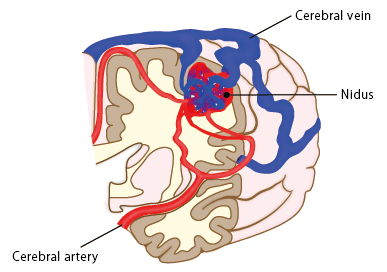- HOME
- For Patients
- Cerebral arteriovenous malformation
Cerebral arteriovenous malformation
- About cerebral arteriovenous malformation
- Symptom of cerebral arteriovenous malformation
- Diagnosis of cerebral arteriovenous malformation
- Treatment of cerebral arteriovenous malformation
About cerebral arteriovenous malformation
This is a congenital condition of the blood vessels in the brain.
Normally, the arteries (the vessels that transport blood, carrying oxygen and nutrients) divide and become narrower, and ultimately form capillaries. The capillaries deliver oxygen and nutrients directly to cells (in the brain this means brain cells, including neurons), with the blood picking up carbon dioxide and waste products before returning. The capillaries that transport this blood join into veins, which then return to the heart. The blood vessels in the brain are divided into arteries, veins, and capillaries before birth, while a baby is still within its mother's womb. During this process, some vessels in the brain may fail to divide properly into capillaries. Instead, an abnormal artery and vein join each other directly to form an abnormal vessel called a cerebral arteriovenous malformation. The blood flowing through a cerebral arteriovenous malformation no longer exchanges oxygen or nutrients, and the arterial blood pressure that should have been widely distributed among the capillaries is instead transmitted directly to the vein.
[ Cerebral arteriovenous malformation (AVM) ]

A tangle of abnormal vessels (a nidus of cerebral arteriovenous malformation) is intervened between cerebral arteries and cerebral veins.







